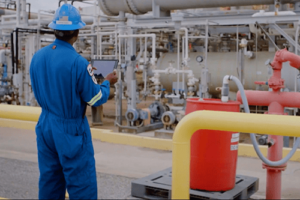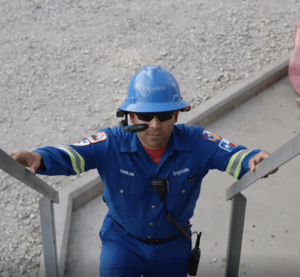Enabling Connected Workers at Texmark Chemicals’ Refinery of the Future (RotF)
Background
Changing demand patterns, complex initiatives, an aging, and retiring workforce, and exponentially increasing data volumes are just a few of the challenges facing the highly competitive oil and gas industry. To overcome these complicated issues, companies like Texmark Chemicals (a petrochemical manufacturer in Galena Park, Texas) are turning to advanced Industrial Internet of Things (IIoT) technologies to modernize their business.
In tandem with a robust team of industry-leading partners (including Hewlett Packard Enterprise, Aruba, PTC, Intel, and more), CBT built Texmark a Refinery of the Future, featuring advanced IIoT capabilities. One of the five core solutions included in the Refinery of the Future project is CBT’s Connected Worker, delivering superior worker efficiency, productivity, and safety.
See how we’re implementing IoT in action at Texmark Chemicals, Refinery of the Future.
Problem

Texmark is a crucial link in the petroleum product supply chain, and because it works with flammable, highly regulated materials, safety is paramount. Texmark’s chemical plant workers are tasked with conducting their duties in and around volatile environments, requiring them to be near process machinery handling high pressure, high temperature, and toxic fluids/gases scattered across acres of landscape. Texmark must ensure that its facility is managed in ways that put the worker and community safety first. However, due to the exceptionally competitive nature of their industry, Texmark must simultaneously drive plant efficiency and productivity.
Historically, Texmark has depended on physical inspections of process equipment to ensure all systems remain in working order. In most cases, the plant operator will need information about the equipment’s performance at that specific moment, information about workflow conditions leading to/from an asset, data about that equipment’s last maintenance service, or historical trends that might provide insight into its present condition. To access that data, the plant worker must call the Control Center and request a verbal readout of performance characteristics on the equipment being inspected. Thus, these plant walk-throughs can be time-consuming and labor-intensive, meaning workers can only reach a certain number of pumps per day. They’re forced to visit all pumps in a routine order (for example, pumps 1-10 on Mondays and 11-20 on Tuesdays, etc.) rather than utilizing real-time data to focus on the pumps that require critical attention and maintenance. Plant workers also have to juggle communications gear while manually adjusting equipment settings, further slowing the process.
Depending solely on physical inspections also carries risk, because it relies on employees who — based on years of experience — can tell if a pump is starting to malfunction by recognizing slight variations in its noise and vibrations. But what happens if an employee with that skill is out sick, or reaches retirement age? Texmark needed ways to institutionalize that type of knowledge and find ways to streamline these highly manual processes.
This innovative IIoT technology will help us become safer, more competitive, and better at everything we do.
Doug Smith, CEO of Texmark Chemicals
Solution

Texmark’s vision for next-generation worker safety, productivity, and efficiency hinged on the emerging promise of IIoT: sensored data collection combined with advanced analytics software and connected devices. CBT integrated an innovative Connected Worker solution into Texmark’s Refinery of the Future to help generate insights, automate the worker’s environment, and reduce the risk of human error.
Step one was establishing the digital foundation by enabling edge-to-core connectivity. CBT and Aruba engineers deployed a secure wireless mesh network with Class 1 Div 1 access points & ClearPass for secure network access control. The wireless solution cost about half of what it would have cost to deploy a hardwired network.
Step two was utilizing that full-campus connectivity, combined with advanced data capture from distributed IoT sensors, and integrating advanced wireless devices and software to enable instant access to critical, real-time plant information. These devices completely overhaul the aforementioned maintenance procedures, making inspections and correctional adjustments much faster, easier and safer.
Handheld Devices: Handheld tablets with custom, menu-driven software provide chemical plant workers with the ability to view live data on all connected assets.
- Sensored data streaming from plant assets in real-time (e.g. temperature, pressure, fluid levels, vibration readings, etc.)
- Operational data as reported on the Digital Control System in the Control Center
- Historical data such as schematics, diagrams, inspection/maintenance reports, analyses, etc.
- Additional software adds capabilities such as augmented reality (AR) asset displays, 3D modeling, digital measurements, risk analysis, predictive maintenance, and more
Hands-Free Devices: Voice-controlled, hands-free wearable android compute integrated into the workers’ safety helmets enables them to interact with people and machinery in a more productive manner
- Unintrusive, the eye-level display shows key performance data dashboards for assets
- The microphone enables verbal commands to the SW applications in use and connects the worker with the Control Center/other remote experts hands-free
- Native noise-cancellation ensures wind, machinery, and other background noises are not a distraction. The device’s voice command capabilities are also unaffected by loud environments
- The camera enables asset identification via a UPC code, voice-enabled picture/video capture, and bi-directional video sharing with remote experts
- Conferencing technologies (Zoom, WebEx, Microsoft Teams, etc.) augment the remote expert capabilities by enabling one-to-many audio/visual conversations as well as one-to-one
CBT has a fantastic team. Everybody I work with at CBT is a great listener. They’re good at gathering intel and learning about what our challenges are, what our pain points are, and really what the solution is that we’re trying to drive towards.
Linda Salinas, VP Operations at Texmark Chemicals
Results
Utilizing the Connected Worker Solution, Texmark’s workers are radically more efficient. Workers now have instant access to, and an optional hands-free visual representation of, all relevant information tied to any connected plant asset. They can approach an asset (ie. a mechanical system such as a vacuum pump) and use QR code recognition to identify the asset’s related documentation, view real-time and historical information about the performance of the asset in question, verbally collaborate with the Control Center or remote experts hands-free, and (if necessary) manually adjust controls on the asset (e.g., valve wheels, pressure devices, variable switches, etc.). All this while viewing live changes to associated key performance attributes of the asset on their AR screen.
Connected Worker also improves Texmark’s worker safety by enabling full use of both hands at all times (especially important when climbing or lifting). Resulting in improved efficiencies that reduce a worker’s time in the hazardous plant environment.
After implementing CBT’s Connected Worker, Texmark saw a 75% decrease in the time it takes their staff to assess asset process conditions. Additionally, they saw a 90% reduction in time taken to file compliance information such as picture documentation of completed procedures.
You can also download the content as a pdf below!
